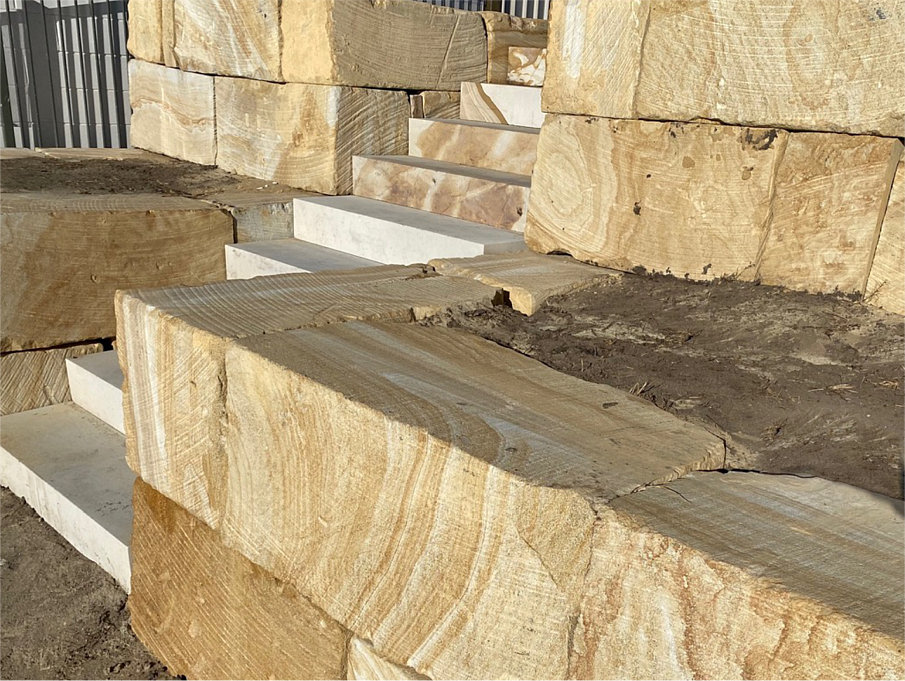When it comes to constructing sandstone retaining walls that are both functional and aesthetically pleasing. Sandstone retaining blocks stand out as a top choice. These blocks, known for their natural beauty and durability, offer an excellent solution for managing sloped terrain, preventing soil erosion, and creating distinctive outdoor spaces. In this blog post, we’ll explore the advantages of building with sandstone retaining blocks and provide tips for incorporating them into your landscape.
Why Choose Sandstone Retaining Blocks?
Sandstone is a sedimentary rock that has been used in construction for centuries, prized for its versatility and timeless appeal. Here are some reasons why sandstone retaining blocks are an excellent choice for your next building project:
- Natural Beauty: Sandstone’s warm, earthy tones and unique textures make it a visually appealing option. Whether you’re aiming for a rustic, natural look or a more refined, elegant appearance, sandstone can be tailored to suit your design preferences. The variety of colors available, from soft yellows to rich reds, allows you to select the perfect hue to complement your landscape.
- Durability and Strength: Sandstone is a durable material that can withstand the elements, making it ideal for outdoor construction. When used in retaining walls, sandstone blocks provide the necessary strength to hold back soil and prevent erosion, ensuring that your wall remains stable and intact for years to come.
- Versatility: Sandstone retaining blocks can be used in a variety of applications, from garden walls to large-scale retaining walls for commercial projects. Their versatility makes them suitable for both small residential gardens and expansive landscapes.
- Eco-Friendly: As a natural material, sandstone is an eco-friendly choice. It requires minimal processing, reducing its environmental impact. Additionally, sandstone is a recyclable material, which means it can be repurposed for future projects.
Incorporating Sandstone Retaining Blocks into Your Landscape
Building with sandstone retaining blocks allows you to create functional and attractive outdoor features. Here are some ideas for incorporating these blocks into your landscape:
- Terraced Gardens: If your property has a slope, consider using sandstone retaining blocks to create terraced gardens. These multi-level garden beds not only prevent soil erosion but also provide additional planting space. The natural beauty of sandstone enhances the visual appeal of your garden, creating a harmonious blend with the surrounding landscape.
- Pathway Edging: Define pathways and walkways with sandstone retaining blocks. The blocks create a clear boundary between your garden beds and pathways, keeping soil and plants in place while adding a touch of elegance to your outdoor space.
- Feature Walls: Use sandstone retaining blocks to construct feature walls that serve as focal points in your garden. Whether you’re framing a water feature, creating a privacy screen, or adding a decorative element to your landscape, sandstone’s natural charm adds character to any design.
- Outdoor Living Areas: Enclose outdoor living spaces, such as patios, fire pits, or seating areas, with sandstone retaining walls. The blocks provide a sturdy barrier that enhances the comfort and coziness of your outdoor space, making it the perfect place to relax and entertain.
- Boundary Walls: For a more substantial project, consider building a boundary wall with sandstone retaining blocks. These walls not only define the edges of your property but also add security and privacy. The natural stone’s durability ensures that your boundary wall will withstand the test of time, while its beauty enhances the overall aesthetic of your property.
Tips for Building with Sandstone Retaining Blocks
- Proper Planning: Before starting your project, take the time to plan your retaining wall carefully. Consider the height and length of the wall, the slope of the terrain, and the drainage requirements. Proper planning will help you avoid common issues such as wall failure or drainage problems.
- Foundation Preparation: A solid foundation is crucial for the stability of your retaining wall. Excavate the area to a suitable depth and create a base layer of compacted gravel or crushed stone. This foundation will help distribute the weight of the wall and prevent settling.
- Block Placement: When laying the sandstone blocks, start at the lowest point of the wall and work your way up. Stagger the joints between blocks to enhance the wall’s stability. Use a level to ensure that each block is properly aligned, and backfill with gravel or soil as you build.
- Drainage Considerations: Proper drainage is essential to prevent water buildup behind the retaining wall, which can cause pressure and lead to wall failure. Incorporate drainage pipes or gravel-filled trenches to direct water away from the wall.
- Maintenance: While sandstone is a durable material, it’s important to inspect your retaining wall regularly for any signs of damage or shifting. Address any issues promptly to maintain the wall’s integrity and appearance.
Conclusion
Building with sandstone retaining blocks is a smart choice for those looking to create durable, attractive, and functional outdoor spaces. Whether you’re tackling a small garden project or a large-scale landscape transformation, sandstone blocks offer the strength, versatility, and beauty needed to bring your vision to life. Embrace the timeless appeal of sandstone and start building a retaining wall that will enhance your property for years to come.





